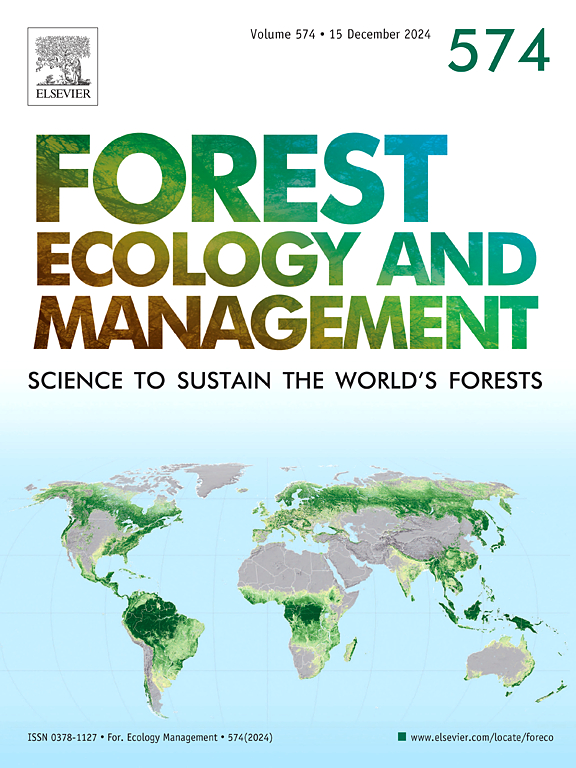C, N and P dynamics during litter decomposition in pure and mixed beech – conifer stands: Effects of litter species, site conditions and native vs non-native conifer species
IF 3.7
2区 农林科学
Q1 FORESTRY
引用次数: 0
Abstract
The plantation of mixed forests including non-native tree species is increasing but its impacts on litter decomposition and nutrient cycling remains little studied across different site conditions. Using litterbags with European beech leaves, Norway spruce or Douglas-fir needles, we investigated litter decomposition processes in monocultures and mixed forests of European beech, Norway spruce and Douglas-fir at nutrient-rich and nutrient-poor sites. Decomposition of each litter species declined in a close to linear way throughout 36 months of exposure, with decomposition of beech leaves being slowest. This was likely driven by low initial nitrogen concentration of beech leaves as reflected by strong and long-lasting accumulation of nitrogen which was more pronounced at nutrient-poor sites. Irrespective of litter species, decomposition was slowest in Norway spruce monocultures, with patterns in mixed forests being generally intermediate between those in respective monocultures. Although mechanisms responsible for slow litter decomposition in Norway spruce monocultures remain unclear, the results show that detrimental effects of Norway spruce monocultures can be mitigated by admixture of European beech. The relatively slow decomposition of beech leaves highlights the predominant role of initial litter nutrient concentrations in driving litter decomposition. The slow decomposition of litter in spruce forests highlights that specific environmental conditions in forest stands may strongly modify litter decomposition, with these modifications being similar across litter species. These findings emphasize the importance of understanding how, by shaping the environment, single tree species influence ecosystem functions such as litter decomposition and nutrient cycling.
纯山毛榉和混交林凋落物分解过程中的碳、氮、磷动态:凋落物种类、立地条件和本地与非本地针叶林的影响
包括外来树种在内的混交林人工林正在增加,但其对凋落物分解和养分循环的影响在不同立地条件下的研究很少。利用装有欧洲山毛榉叶、挪威云杉或道格拉斯冷杉针叶的垃圾袋,研究了营养丰富和营养贫乏地区欧洲山毛榉、挪威云杉和道格拉斯冷杉单一栽培和混交林凋落物分解过程。在36个月的暴露过程中,各凋落物的分解呈接近线性的下降趋势,其中山毛榉叶的分解最慢。这可能是由于山毛榉叶片的初始氮浓度较低,反映了氮的强烈和持久积累,这在营养贫乏的地方更为明显。无论凋落物种类如何,挪威云杉单一栽培的凋落物分解最慢,混交林的凋落物分解模式一般介于各自单一栽培的凋落物分解模式之间。尽管挪威云杉单一栽培凋落物缓慢分解的机制尚不清楚,但研究结果表明,欧洲山毛榉的混合可以减轻挪威云杉单一栽培的有害影响。山毛榉叶片分解相对缓慢,说明凋落物初始养分浓度对凋落物分解具有主导作用。云杉林凋落物的缓慢分解表明,林分的特定环境条件可能会强烈地改变凋落物的分解,这些改变在不同的凋落物种类中是相似的。这些发现强调了理解单一树种如何通过塑造环境来影响凋落物分解和养分循环等生态系统功能的重要性。
本文章由计算机程序翻译,如有差异,请以英文原文为准。
求助全文
约1分钟内获得全文
求助全文
来源期刊

Forest Ecology and Management
农林科学-林学
CiteScore
7.50
自引率
10.80%
发文量
665
审稿时长
39 days
期刊介绍:
Forest Ecology and Management publishes scientific articles linking forest ecology with forest management, focusing on the application of biological, ecological and social knowledge to the management and conservation of plantations and natural forests. The scope of the journal includes all forest ecosystems of the world.
A peer-review process ensures the quality and international interest of the manuscripts accepted for publication. The journal encourages communication between scientists in disparate fields who share a common interest in ecology and forest management, bridging the gap between research workers and forest managers.
We encourage submission of papers that will have the strongest interest and value to the Journal''s international readership. Some key features of papers with strong interest include:
1. Clear connections between the ecology and management of forests;
2. Novel ideas or approaches to important challenges in forest ecology and management;
3. Studies that address a population of interest beyond the scale of single research sites, Three key points in the design of forest experiments, Forest Ecology and Management 255 (2008) 2022-2023);
4. Review Articles on timely, important topics. Authors are welcome to contact one of the editors to discuss the suitability of a potential review manuscript.
The Journal encourages proposals for special issues examining important areas of forest ecology and management. Potential guest editors should contact any of the Editors to begin discussions about topics, potential papers, and other details.
 求助内容:
求助内容: 应助结果提醒方式:
应助结果提醒方式:


